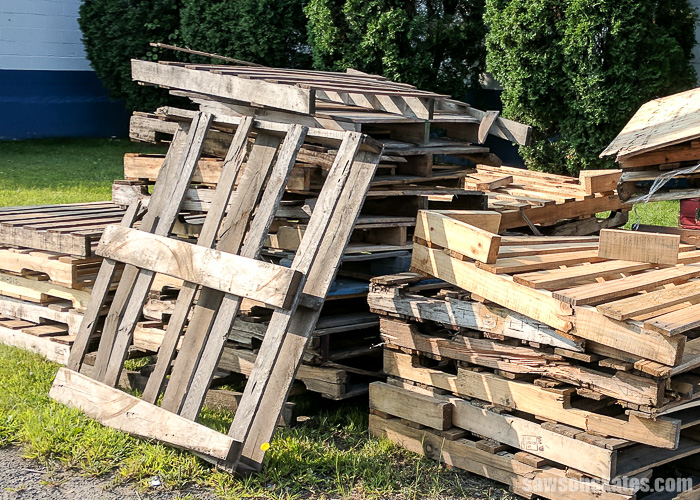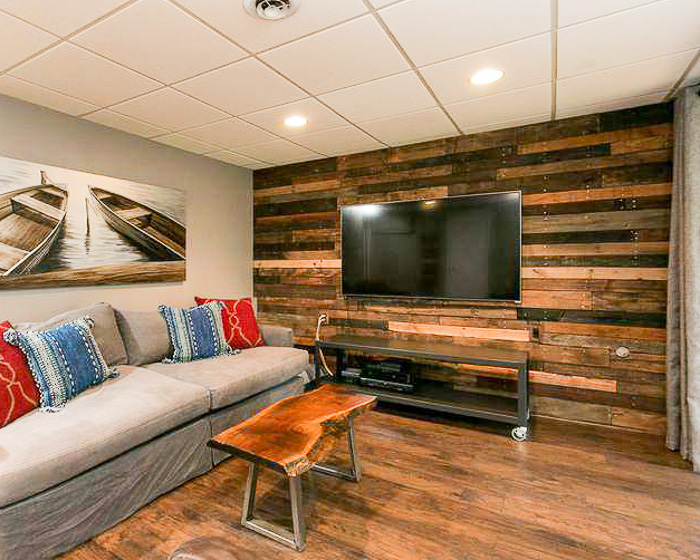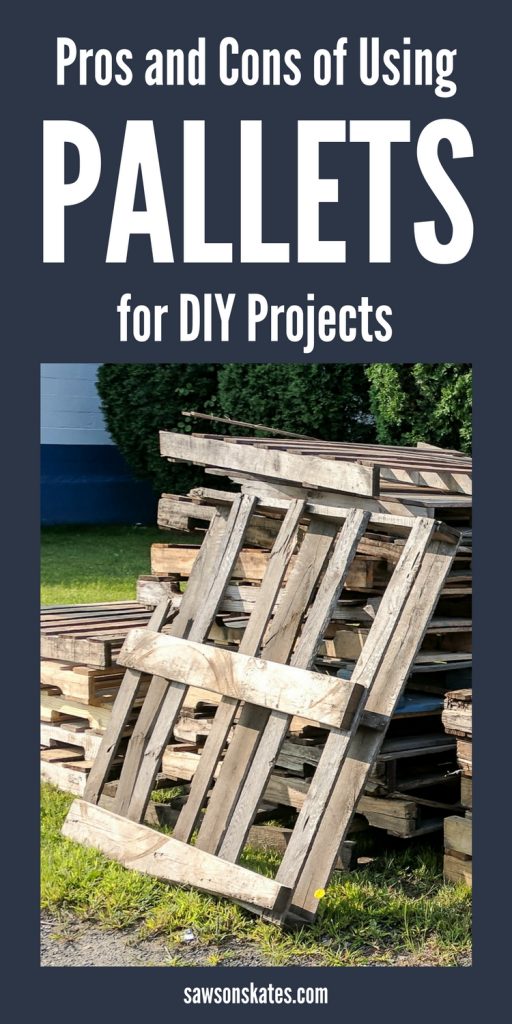Building with Pallets Has Pros and Cons
Pallet wood is often used to make accent walls and furniture projects, but there are a few things to consider before you start building with pallets.
Pallets are available for free just about everywhere. I’ve seen them along the side of the road, behind stores, and near warehouses. Some DIYers use pallets to save money. Others use pallets because they enjoy recycling. And some just like the weathered look of pallet wood. Whatever the reason, there are a few things to consider before building with pallets. Are pallets safe to use? How will you take them apart? How do you get the nails out? We’ll explore all of these questions and a few more as we look at using pallets to build DIY projects.
Helping me today with this look at the pros and cons of building with pallet wood is my friend Alison. Alison is an avid DIYer, lover of home decor, and has used pallets to build two accent walls. She’s a self-described “pallet wall pro”! Alison said, “My project turned out to be one of the reasons the buyer bought my house so quickly AND above the asking price!” I’m excited to have Alison here to share her knowledge of pallets with us.
You may also enjoy 14 Places to Buy Barn Wood
For your convenience, this post contains affiliate links to supplies or tools I used to complete this project. Purchases made using these links help support the Saws on Skates website and allow me to share more DIY projects. and DIY tips with you. There is no cost to you for using these links. Click here to visit my site policies.
Building with Pallets Has Pros and Cons for DIY Projects
Are Pallets Safe to Use?
In the past, pallets were treated with chemicals to make them last longer. Newer pallets are no longer treated with those chemicals. This is good news because breathing in sawdust that was saturated with chemicals is not good for our lungs.
But there’s something else to think about. It’s what Alison refers to as the “ick factor”. What was transported on the pallets that you’re using? Was it a dangerous chemical that may have leaked onto the pallet? Was it in a warehouse with mice or rats? This Mayo Clinic article says rodent droppings and rodent urine can contain viruses that are dangerous to humans.
Alison’s advice is to “use clean, unused pallets.” She says “They’re healthier and less time-consuming” to work with. She recommends to “spray the wood with a bleach and water solution” to remove any possible contaminants” when working with used pallets.
When building with pallets, it’s important to protect our protect eyes with safety glasses, lungs with a quality respirator, and our hands with work gloves.
How Will You Get Pallets to Your Workshop?
Before you begin working with pallet wood you first need to get the pallets to your workshop. Do you have a vehicle large enough to accommodate a couple of pallets? I know what you’re thinking. You’re thinking “Is this the only drawback to using pallet wood this bald guy could come up with?!” Don’t laugh… this is a pretty important question! I can’t tell you the number of times I’ve been walking into or out of a big box store and seen some perplexed patrons in the parking lot.
You know the look I’m talking about. The “Uh uh uh… I just bought this giant (insert giant object here) and there is no way this is fitting in my car!”
So this is a valid question. How will you get the pallets home? Do you have a truck or car large enough to fit pallets? Do you have a buddy with a truck or car who can help you pick up the pallets? Work out the transportation details before you decide to work with pallet wood.
How Do You Take a Pallet Apart?
Now that you have the pallet at your workshop how will you take it apart? If you have never taken a pallet apart let me tell you it can be hard work! Pallets are built so they can be used over and over. Pallets are built so they DON’T come apart! A pallet is constructed with spiral shank nails. The spiral nails look similar to a screw. Those twisted edges bite into the surrounding wood and prevent the nail from coming loose.
Hammer and Pry Bar
I used a hammer and pry bar to take apart a few pallets and not only was it hard work, I ruined the wood trying to remove the nails. Those spiral shank nails do a great job of keeping the pallet together! Just imagine trying to use a pry bar to remove a screw. That screw will bite into the wood and the wood surrounding the screw will crack. When using a hammer and pry bar you have a greater chance of breaking or splitting the wood which will basically make your pallet wood useless. I recommend not taking your pallets apart with a hammer and pry bar.
Sawzall
Alison’s go-to tool for taking apart pallets is a Sawzall. A Sawzall makes quick work of taking a pallet apart and there is very little chance of breaking or splitting the wood. There is a chance you could cut into the wood you’re trying to save so its best to go slow and watch where the blade is cutting to avoid accidentally cutting into the wood. Alison says “It helps to have a partner to help with this. One person uses the saw and the other stands on or holds the pallet.”
An oscillating tool also works for taking a pallet apart. Compared to the Sawzall the shorter blade gives you more control and so there is a lesser chance of cutting through the wood you’re trying to save.
Another consideration when using a Sawzall or an oscillating tool is you will be left with a piece of a nail in the wood. I remember watching an episode of the New Yankee Workshop where Norm Abrams used recycled wood for a project. Before cutting the wood Norm used a metal detector to be sure he removed all of the nails. I’m not suggesting you need to buy a metal detector, but I do think you should consider how to remove the remaining portion of the nail from the wood.
Maybe it’s just because I’m paranoid about safety, but if we miss removing a nail couldn’t that nail potentially become a projectile when we’re cutting the wood with a miter saw or table saw?! Not only that, but nails are not kind to saw blades.
Pallet Breaker Tool
Another option for taking a pallet apart is a special pallet breaker tool. A pallet breaker is specifically designed to make taking a pallet apart easier. You can read the positive reviews of owners and watch the YouTube videos to see just how easy these tools are to use.
A pallet breaker tool works like a pry bar, but the difference is it’s designed to exert pressure equally on the board which reduces the chances of the board breaking or splitting. I’ve personally never tried a pallet breaker, but if I was going to take apart a lot of pallets I would invest in a pallet breaker tool.
Let Pallet Wood Acclimate
Most of the time you’ll find your pallets sitting outside. This means they could be wet from rain, dew, etc. Before you use your pallet wood you should let it acclimate to the humidity levels of your home. If you take a pallet apart and start building with it immediately, chances are the moisture level of the pallet will be greater than your home. This means as the pallet wood releases moisture it will begin to shrink. As it shrinks the chances increase that it will crack and split.
Related: Mistakes with Wood Can Cause Your DIY Furniture to Crack
Pallet Wood Can Wear Blades More Quickly
From my experience most pallets are made of hardwoods like oak. Hardwoods are durable and can take a lot of abuse, so they’re a great choice for building pallets. Oak is also a great choice for building furniture projects because of its durability and beautiful grain patterns.
Related: 7 Tips for Using a Pocket Hole Jig with Hardwoods
Compared to softwoods like pine, hardwoods tend to cut much more slowly. Not only that, but hardwoods, you know cuz they’re hard, can also wear saw blades more quickly. This could mean that you may need to replace your saw blades more often.
While we’re talking saw blades what type of saw blade do you use? In my 7 Miter Saw Tricks Every DIYer Should Know post I recommend replacing stock miter saw blades with this saw blade. I love the smooth cuts it makes for my DIY furniture projects.
Related: Is Your Saw Blade Dull or Dirty?
Is Pallet Wood the Right Choice For Your Project?
What type of projects do you plan to build with your pallet wood? Do you plan to build DIY furniture projects like fine furniture or rustic style furniture? Or do you plan to make an accent wall like Alison?
If you’re planning to build fine furniture pallet wood might not be the best option for you. Remember earlier how I said it’s important to remove the nails from your pallet wood? After removing the nail, you’ll be left with a nail hole. Those holes will need to be filled and you don’t typically find nail holes on the faces of boards on fine furniture.
Related: How to Make a DIY Wood Filler
If you leave the cutoff nail or miss removing a nail, you’ll see a shiny piece of metal in the surface of your DIY furniture project. Again, you wouldn’t typically see a cutoff nail in a piece of fine furniture.
Pallet wood is typically rough sawn which means it doesn’t have smooth faces like wood you would buy at a big box store. This means in order to get pallet wood ready to build fine furniture it would need to be planned or sanded. A planer is a great tool, but it’s a little pricey if your goal for using pallet wood is to save money. Again, be sure to remove all of those nails. Nails are not kind to planer knives.
If you plan to sand your pallet wood get ready to do lots of sanding. As I mentioned earlier most pallets are made with hardwoods like oak. Have you ever sanded oak? It doesn’t sand nearly as easily as a softwood like pine does.
Related: 11 Secrets for Sanding Wood Projects Like a Pro
Another consideration for using pallets for building fine furniture is the length of pallet wood is typically short. This means for bigger furniture projects you’ll need to piece lumber together or possibly use wood from a source other than a pallet.
If you’re planning to build rustic furniture pallet wood is a great option. There is little that needs to be done to prep pallet wood to build rustic furniture. You’ll likely not want to fill the nail holes as the holes will add character to the piece. The same goes for the rough surfaces. You’ll likely not want to plane or sand (or sand too much) as the rough texture will add character to your rustic furniture.
As a “pallet wall pro” Alison thinks pallet wood is the perfect choice for an accent wall. As she mentioned earlier her accent wall was a major selling point for her home. Alison recommends when you are doing a pallet wall that it’s helpful to make piles of wood separating them by width. She says “Likely there will still be cutting, but this step is crucial otherwise you’ll be bombarded with random piles of wood!”
Before attaching any pallet wood to the wall Alison tells me it’s important to paint the wall a dark color. “If there is even the tiniest of gaps, a light colored wall will peek through and if you’re anal like me, you will always see it!” Next, she lightly sanded the pallet wood and stained. Alison cautions “Each piece will take stain differently, so be aware of that as well.” She attached the wood to the wall two different ways. The first time she used nails and glue directly on the wall. The second time she attached furring strips to the wall and then attached the pallet wood to the furring strips. Isn’t Alison’s pallet wall gorgeous?!
Final Thoughts
No matter if your goal is to save money or to be green for many DIYers pallets are their go-to source for wood. Working with pallet wood has pros and cons, but armed with some knowledge, those drawbacks are easy to workaround.
Do you use pallets to build your DIY projects? Did I miss a benefit or drawback? Do you have any tips or tricks for working with pallets? Please share them with me in the comments.
Thank you for stopping by to check out the pros and cons of pallets. If you found this information helpful, would you please pin it to Pinterest? I’d really appreciate it! Thank you – Scott




When using pallet wood or reusing any wood of unknown history, I wash it with dish soap in water and a large soft brush, rinse it with a garden hose, and let it dry. To minimize sawdust that I prefer not to breathe or get on me, I work outside and use power tools as little as possible. After at least one application of any kind of finish, I feel satisfied that any remaining contaminants in the wood are pretty safely sealed in.
I received a bunch of pallets last fall and have tried different ways to disassemble, most of these pallets have 8 boards on one side and 7 on the other as well as 4 2×4’s. What I found that works great is a screw jack to remove the boards on 1 side ( mine is from an 80’s Olds and just the right height). Then I flip it over and use a piece of 4 x 6 as blocking under the ends and then the center and drive the 2×4 down with a block and 3 lb hammer. Very little end damage and most of the nails are in the boards not the 2×4’s